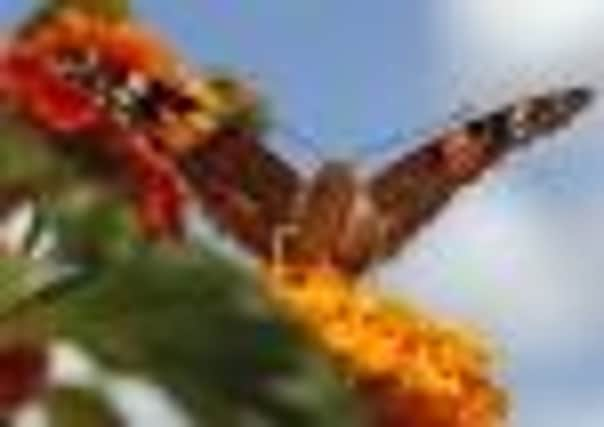Dawn Morrison: Beauties once lost now warming to the Lothians


The decline in the number of butterfly species in the UK over the last decade has been dramatic.
If the absence of a variety of butterflies from summer gardens and parks in recent years isn’t evidence enough, a recent study by Butterfly Conservation and the Centre for Ecology and Hydrology (CEH) showed a reduction of almost three quarters of butterfly species in the UK.
Advertisement
Hide AdAdvertisement
Hide AdHowever, last year brought a rare piece of good news in the reappearance of the comma – an orange-and-black species with a white marking on its underwings which gives it its name – which warmed the hearts of conservationists.
The holly blue butterfly has also started moving into the area and can now be seen in Edinburgh gardens.
Also moving in is the speckled wood variety, a recent coloniser from England, and the eye-catching green hairstreak.
Head of surveys for Butterfly Conservation, Richard Fox, said: “We’re pretty certain that the butterflies are responding to climate change.
“A butterfly like the comma used to occur in Scotland about 150 years ago, but it then disappeared from Scotland and also across the north of England.
“From the 1920s, they started to spread and even more so since the seventies and eighties, when climate change started kicking in. Commas have spread very rapidly into Scotland – and there is no sign of the trend slowing down.”
This year, butterflies fared better in Scotland than in England, where there have been large population decreases in farmland and woodland habitats.
Butterflies are seen as indicator species, with different species often reliant on one or two specific types of plant, so these serious declines may represent a wider UK biodiversity crisis.
Advertisement
Hide AdAdvertisement
Hide Ad“I think the main thing that people talk about – and has been shown to be a real change – is, rather than the number of species, the number of butterflies,” said Mr Fox. “People often talk about how they used to go for walks and see clouds of butterflies. We’ve recorded massive reductions in the numbers of butterflies.”
Fortunately, it seems it is not just butterflies which have been enjoying a renaissance in the Lothians.
The nuthatch – a plump bird resembling a small woodpecker – breeds in southern England and Wales, but has gradually been moving north.
In the Lothian Bird Report, the nuthatch was described as a “very rare vagrant”, with only five previous records in 1865, 1985 and 1998.
However, by 2005, it was a rapidly increasing species in Lothian, with breeding confirmed at Smeaton and Roslin Glen Scottish Wildlife Trust Reserve.
The raven has also become more widespread, and the buzzard, another species which was quite rare in the Lothians, is now a fairly common sight after a rapid recolonisation in the early 1990s. Tree sparrows have bounced back after reaching very low levels.
Most of the records held by The Wildlife Information Centre are for the eastern and southern Borders, but there are localised sightings for the species in East Lothian at the Gosford Estate and south-west of Aberlady Bay. However, the reason the birds have fared so well is not quite so well understood as it is for butterflies, explained Mike Fraser, RSPB conservation officer for Lothian and Borders.
“There are all sorts of reasons for birds reappearing and it’s not that easy to pin them down.
Advertisement
Hide AdAdvertisement
Hide Ad“We think it may be because of the overall trend for warmer winters, species like the nuthatch are beginning to move north.
“There are also a lot more people feeding birds in their back gardens.
“In the Lothians in 2006, there were only eight sightings of the nuthatch and by 2007, we were up to 30. It used to be a very rare bird, but they now appear to be moving into more urban areas and on to bird tables. It’s pretty impressive.”
Species which have increased their range in recent years include the roe deer and otter. Cleaner water and abundant fish stocks are believed to have played a significant part in increasing the number of otters in East Lothian.
It is not all good news, with a number of birds and butterflies, the treasured red squirrel and the water vole all under threat.
But for the moment, conservationists are enjoying welcoming new species to the Lothians.
“It’s certainly quite an exciting time for those who are interested in butterflies, particularly in the south of Scotland where there has been a whole new raft of species,” said Mr Fox.
“But we must be mindful of some of the problems rarer species are experiencing and the threat to the largely unspoilt landscape of Scotland.”
UNDER THREAT
Advertisement
Hide AdAdvertisement
Hide AdAcross the Lothians, many species are struggling to survive.
The black grouse is now described as very vulnerable, and numbers of the yellow wagtail have been in decline.
The red squirrel population is well-publicised as having been decimated because of a disease carried by the non-native grey squirrel.
The water vole is also under threat.
And already having disappeared – or likely to have disappeared – is the corn bunting, a farmland bird often seen perched on a wire or post.
Recent years have seen numbers of marsh and willow tits fall, and the roseate tern – one of the UK’s rarest seabirds – and little tern have also declined in numbers.